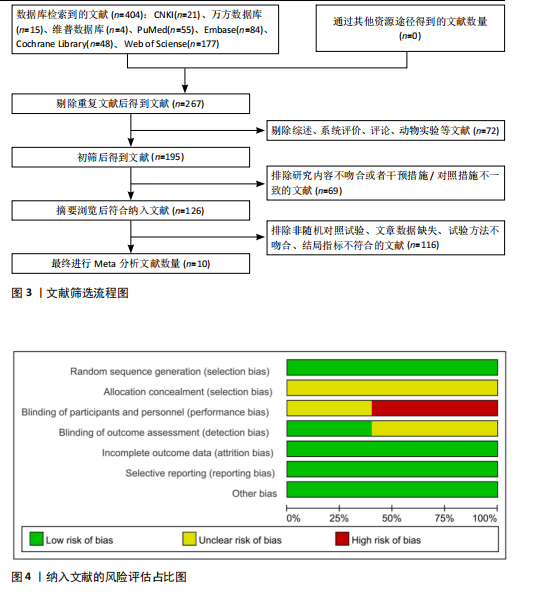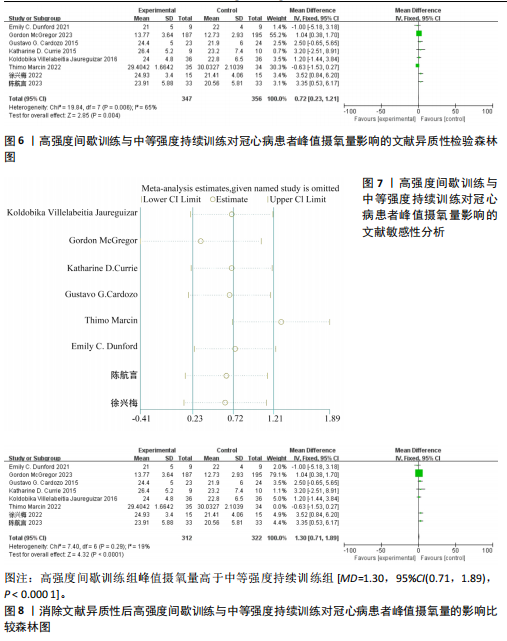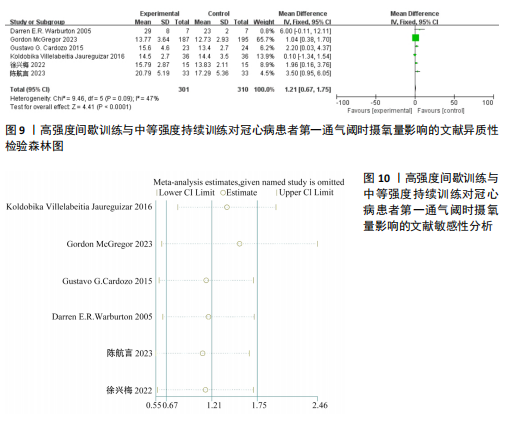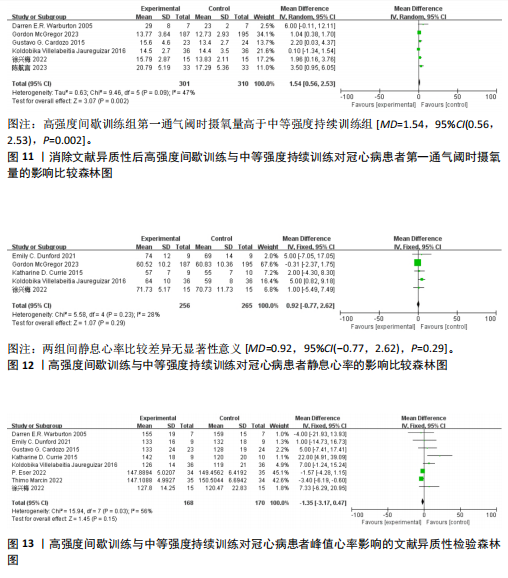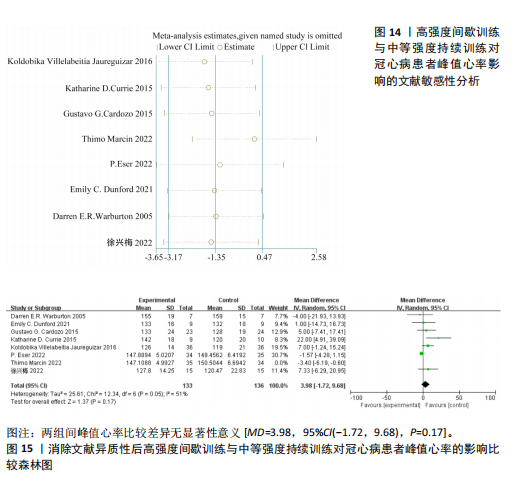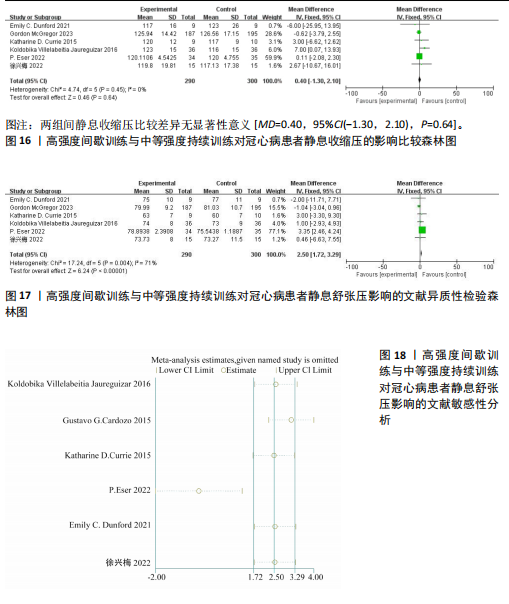[1] YANG Q, WANG L, ZHANG X, et al. Impact of an enhanced recovery after surgery program integrating cardiopulmonary rehabilitation on post-operative prognosis of patients treated with CABG: protocol of the ERAS-CaRe randomized controlled trial. BMC Pulm Med. 2024;24(1):512-534.
[2] FENG S, LI M, FEI J, et al. Ten-year outcomes after percutaneous coronary intervention versus coronary artery bypass grafting for multivessel or left main coronary artery disease: a systematic review and meta-analysis. J Cardiothorac Surg. 2023;18(1): 54-65.
[3] DUN Y, THOMAS RJ, MEDINA-INOJOSA JR, et al. High-Intensity Interval Training in Cardiac Rehabilitation: Impact on Fat Mass in Patients With Myocardial Infarction. Mayo Clin Proc. 2019;94(9):1718-1730.
[4] YU AKD, KILIC F, DHAWAN R, et al. High-Intensity Interval Training Among Heart Failure Patients and Heart Transplant Recipients: A Systematic Review. Cureus. 2022;14(1):e21333.
[5] OKAMURA M, SHIMIZU M, YAMAMOTO S, et al. High-intensity interval training versus moderate-intensity continuous training in patients with heart failure: a systematic review and meta-analysis. Heart Fail Rev. 2023;28(5):1113-1128.
[6] JAUREGUIZAR KV, VICENTE-CAMPOS D, BAUTISTA LR, et al. Effect of High-Intensity Interval Versus Continuous Exercise Training on Functional Capacity and Quality of Life in Patients With Coronary Artery Disease: A RANDOMIZED CLINICAL TRIAL. J Cardiopulm Rehabil Prev. 2016;36(2):96-105.
[7] MCGREGOR G, POWELL R, BEGG B, et al. High-intensity interval training in cardiac rehabilitation: a multi-centre randomized controlled trial. Eur J Prev Cardiol. 2023; 30(9):745-755.
[8] CURRIE KD, BAILEY KJ, JUNG ME, et al. Effects of resistance training combined with moderate-intensity endurance or low-volume high-intensity interval exercise on cardiovascular risk factors in patients with coronary artery disease. J Sci Med Sport. 2015;18(6):637-642.
[9] CARDOZO GG, OLIVEIRA RB, FARINATTI PT. Effects of high intensity interval versus moderate continuous training on markers of ventilatory and cardiac efficiency in coronary heart disease patients. Sci World J. 2015;2015:192479.
[10] MARCIN T, TRACHSEL LD, DYSLI M, et al. Effect of self-tailored high-intensity interval training versus moderate-intensity continuous exercise on cardiorespiratory fitness after myocardial infarction: A randomised controlled trial. Ann Phys Rehabil Med. 2022;65(1):101490.
[11] ESER P, JAEGER E, MARCIN T, et al. Acute and chronic effects of high-intensity interval and moderate-intensity continuous exercise on heart rate and its variability after recent myocardial infarction: A randomized controlled trial. Ann Phys Rehabil Med. 2022;65(1): 01444.
[12] DUNFORD EC, VALENTINO SE, DUBBERLEY J, et al. Brief Vigorous Stair Climbing Effectively Improves Cardiorespiratory Fitness in Patients With Coronary Artery Disease: A Randomized Trial. Front Sports Act Liv. 2021;3:630912.
[13] WARBURTON DE, MCKENZIE DC, HAYKOWSKY MJ, et al. Effectiveness of high-intensity interval training for the rehabilitation of patients with coronary artery disease. Am J Cardiol. 2005;95(9): 1080-1084.
[14] 陈航言,韦丽华,钟美容,等.高强度间歇训练对老年冠心病患者认知衰弱的影响[J].中国实用护理杂志,2023,39(8): 587-592.
[15] 徐兴梅.HIIT对稳定性冠心病患者心脏自主神经功能及抑郁心理的影响[D].昆明:昆明医科大学,2022.
[16] CAMPBELL WW, KRAUS WE, POWELL KE, et al. High-Intensity Interval Training for Cardiometabolic Disease Prevention. Med Sci Sports Exerc. 2019;51(6):1220-1226.
[17] YIN M, LI H, BAI M, et al. Is low-volume high-intensity interval training a time-efficient strategy to improve cardiometabolic health and body composition? A meta-analysis. Appl Physiol Nutr Metab. 2024;49(3):273-292.
[18] YU H, ZHAO X, WU X, et al. High-intensity interval training versus moderate-intensity continuous training on patient quality of life in cardiovascular disease: a systematic review and meta-analysis. Sci Rep. 2023; 13(1):13915.
[19] ROMERO-VERA L, ULLOA-DÍAZ D, ARAYA-SIERRALTA S, et al. Effects of High-Intensity Interval Training on Blood Pressure Levels in Hypertensive Patients: A Systematic Review and Meta-Analysis of Randomized Clinical Trials. Life (Basel). 2024;14(12):1661-1675.
[20] ZHANG X, XU D, SUN G, et al. Effects of high-intensity interval training in patients with coronary artery disease after percutaneous coronary intervention: A systematic review and meta-analysis. Nurs Open. 2021;8(3): 1424-1435.
[21] YANG Y, LV Q, ZHANG X, et al. Effects of high-intensity interval training on cardiorespiratory function in coronary artery disease: An overview of systematic reviews. Ann Phys Rehabil Med. 2024;68(2):101878.
[22] MITCHELL BL, LOCK MJ, DAVISON K, et al. What is the effect of aerobic exercise intensity on cardiorespiratory fitness in those undergoing cardiac rehabilitation? A systematic review with meta-analysis. Br J Sports Med. 2019;53(21):1341-1351.
[23] TAYLOR JL, BONIKOWSKE AR, OLSON TP. Optimizing Outcomes in Cardiac Rehabilitation: The Importance of Exercise Intensity. Front Cardiovasc Med. 2021;8:734278.
[24] LETNES JM, DALEN H, VESTERBEKKMO EK, et al. Peak oxygen uptake and incident coronary heart disease in a healthy population: the HUNT Fitness Study. Eur Heart J. 2019;40(20):1633-1639.
[25] CARBONE S, KIM Y, KACHUR S, et al. Peak oxygen consumption achieved at the end of cardiac rehabilitation predicts long-term survival in patients with coronary heart disease. Eur Heart J Qual Care Clin Outcomes. 2022;8(3):361-367.
[26] GOMES-NETO M, DURÃES AR, CONCEIÇÃO LSR, et al. High-intensity interval training versus moderate-intensity continuous training on exercise capacity and health-related quality of life in patients with coronary artery disease: An updated systematic review and meta-analysis. Braz J Phys Ther. 2025;29(1):101137.
[27] MILANI JGPO, MILANI M, CIPRIANO GFB, et al. Exercise intensity domains determined by heart rate at the ventilatory thresholds in patients with cardiovascular disease: new insights and comparisons to cardiovascular rehabilitation prescription recommendations. BMJ Open Sport Exerc Med. 2023;9(3):e001601.
[28] DU L, ZHANG X, CHEN K, et al. Effect of High-Intensity Interval Training on Physical Health in Coronary Artery Disease Patients: A Meta-Analysis of Randomized Controlled Trials. J Cardiovasc Dev Dis. 2021;8(11): 158-176.
[29] YUE T, WANG Y, LIU H, et al. Effects of High-Intensity Interval vs. Moderate-Intensity Continuous Training on Cardiac Rehabilitation in Patients With Cardiovascular Disease: A Systematic Review and Meta-Analysis. Front Cardiovasc Med. 2022;9:845225.
[30] SULTANA RN, SABAG A, KEATING SE, et al. The Effect of Low-Volume High-Intensity Interval Training on Body Composition and Cardiorespiratory Fitness: A Systematic Review and Meta-Analysis. Sports Med. 2019;49(11):1687-1721.
[31] 陈琴,张培珍.不同运动方式对高血压的影响[J].中华高血压杂志(中英文),2024, 32(8):787-795.
[32] SARVASTI D, LALENOH I, OEPANGAT E, et al. Cardiovascular Protection Variables Based on Exercise Intensity in Stable Coronary Heart Disease Patients After Coronary Stenting: A Comparative Study. Vasc Health Risk Manag. 2020;16:257-270.
[33] EDWARDS JJ, DEENMAMODE AHP, GRIFFITHS M, et al. Infographic. Exercise training and resting blood pressure: a large-scale pairwise and network meta-analysis of randomised controlled trials. Br J Sports Med. 2023;57(20):1335-1336.
[34] NAYOR M, XANTHAKIS V, TANGUAY M, et al. Clinical and Hemodynamic Associations and Prognostic Implications of Ventilatory Efficiency in Patients With Preserved Left Ventricular Systolic Function. Circ Heart Fail. 2020;13(5):e006729.
[35] JOU J, ZHOU X, LINDOW T, et al. Heart rate response and recovery in cycle exercise testing: normal values and association with mortality. Eur J Prev Cardiol. 2025;32(1):32-42.
[36] FOX K, FORD I, STEG PG, et al. Heart rate as a prognostic risk factor in patients with coronary artery disease and left-ventricular systolic dysfunction (BEAUTIFUL): a subgroup analysis of a randomised controlled trial. Lancet. 2008; 372(9641):817-821.
[37] 戴华,苗德军,赵黎明,等.静息心率与老年冠心病关系的研究[J].中华老年心脑血管病杂志,2012,14(9):937-938.
[38] ROH J, RHEE J, CHAUDHARI V, et al. The Role of Exercise in Cardiac Aging: From Physiology to Molecular Mechanisms. Circ Res. 2016;118(2):279-295.
[39] WANG H, LIU Z, SHAO J, et al. Immune and Inflammation in Acute Coronary Syndrome: Molecular Mechanisms and Therapeutic Implications. J Immunol Res. 2020;2020:4904217.
[40] LAWLER PR, BHATT DL, GODOY LC, et al. Targeting cardiovascular inflammation: next steps in clinical translation. Eur Heart J. 2021;42(1):113-131.
[41] SAMUEL M, TARDIF JC, BOUABDALLAOUI N, et al. Colchicine for Secondary Prevention of Cardiovascular Disease: A Systematic Review and Meta-analysis of Randomized Controlled Trials. Can J Cardiol. 2021;37(5): 776-785.
[42] BANI HANI DA, ALSHRAIDEH JA, SALEH A, et al. Lymphocyte-based inflammatory markers: Novel predictors of significant coronary artery disease. Heart Lung. 2024; 70:23-29.
[43] MANGALESH S, DUDANI S, MAHESH NK. Development of a Novel Inflammatory Index to Predict Coronary Artery Disease Severity in Patients With Acute Coronary Syndrome. Angiology. 2024;75(3):231-239.
[44] VESTERBEKKMO EK, AKSETØY IA, FOLLESTAD T, et al. High-intensity interval training induces beneficial effects on coronary atheromatous plaques: a randomized trial. Eur J Prev Cardiol. 2023;30(5):384-392.
|

